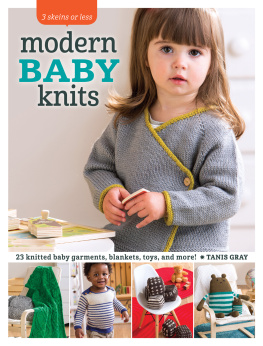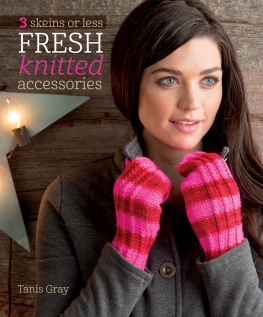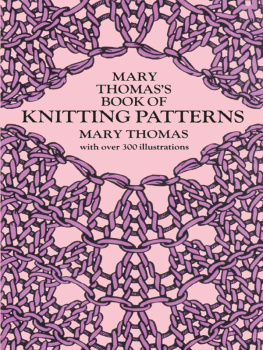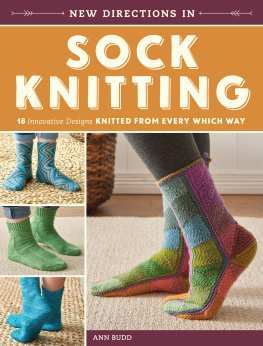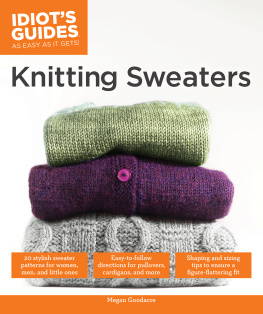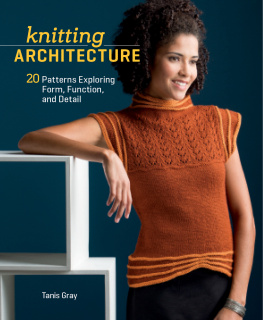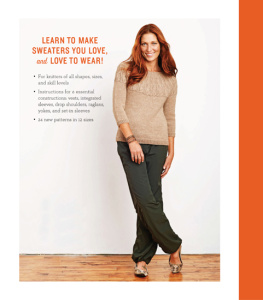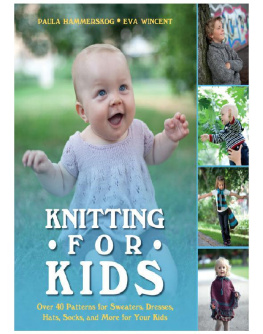knitting
ARCHITECTURE
20 Patterns Exploring
Form, Function,
and Detail
Tanis Gray

contents
chapter 1
FORM FOLLOWS FUNCTION
Kings College Pullover
Mari Muinonen
Burj Al Arab Skirt
Olga Buraya-Kefelian
Sagrada Familia Cardigan
Cirilia Rose
Porticus Socks
Marjan Hammink
Opera House Shell
Suvi Simola
Wrought Iron Tote
Angela Hahn
Fallingwater Hat
Katharina Nopp
chapter 2
THE DETAILS
Pompidou Wrap
Grace Anna Farrow
Arts and Crafts Cardigan
Amy Christoffers
Mucha Cardigan
Glenna Harris
Beaux Arts Cardigan
Cecily Glowik MacDonald
Persian Shawl
Kirsten Kapur
Byzantine Pullover
Tanis Lavalle
Fisher Building Mittens
Jane Dupuis
Rococo Mittens
Jane Dupuis
chapter 3
THE MATERIALS
Tower of Pisa Shift
Veera Vlimki
Bauhaus Cardigan
Ann Weaver
Hotel Tassel Wrap
sa Tricosa
Birds Nest Shrug
Tanis Gray
Erechtheion Pullover
Maria Leigh

introduction
Have you ever stood in wonder, stopped dead in your tracks by a stunning building? How about by a beautiful sweater? We have dozens of museums the world over dedicated to architecture or apparel, but have you ever thought about how similar the two are?
I have always been fascinated by architecture. Something as simple as a large box in which we dwell can suddenly become a stunning, ultramodern structure, or be covered in ornate details inspired by movements in history, the climate, or a clever idea. Similarly, designing knitwear starts with an idea, a blueprint or schematic, math, materials, and a little bit of inspiration. A hat on the person in front of us at the grocery store, a flower on the side of a barren highway, a masterpiece hanging on the wall of a gallery, or a historic building in the middle of a modern city are all inspiration for what we can create with our knitting needles.
My husband, Roger, works at an engineering and architecture firm in Washington, D.C., as the director of sustainability. On our first date, we talked about our workour passions and hobbies. I was struck by how incredibly different our paths and lines of work were, yet how similar the process was. The planning stages are the same (on much different scales), and the creative process and the taking and giving of ideas as we try to make the designs work can be difficult. In the end, we are both helping an idea come to life.
I hope this book inspires the designer and inner architect in all of us. Dream (and knit) to the limits of your imagination. Thats what the designers in this book have done, and it is what makes our craft abundant with possibilities.

chapter 1
Form FOLLOWS Function
The simple idea that form follows functionfirst mentioned in 1852 by American sculptor Horatio Greenough and coined four decades later by American architect Louis Sullivanwould become a major factor in architectural plans and industrial design in the twentieth century. The idea is that the purpose of an object or building is of the utmost importance, and only after it is achieved then should design follow. Some modern architects have taken the idea of simple forms following function a step further and have chosen to have little or no ornamentation at all, believing that less is more.
This notion that a solid foundation, support structure, and a simple shell have utmost importance is easily applicable to the knitting world. Using our bodies as a foundation, we can create beautiful, effortless designs with elements borrowed from architecture. Like designers of buildings, designers of sweaters need to think critically about ornamentation and decide whether it enhances or hinders the end result.
The need for a strong, solid function is elemental. Similar to how structures need push and pull to help them move with the elements, we need our knitwear to be able to move with the push and pull of our bodies. Construction can be the difference between a garment and a garment with purpose. The gentle shaping of a neckline enforced by cables, ribbing on the side of a skirt to shape the form properly, or switching a stitch pattern at the waistline to accentuate its shape are all basic architectural choices we make before even casting on. Just like working on a building, we start by creating a blueprint based on a concept, and then we straighten out the basic construction, do the math, and begin.

kings college PULLOVER
Mari Muinonen
Evoking the vaults, buttresses, and ancient archways of Gothic buildings, this structured pullover by Mari Muinonen is wearable architecture. The nested cabling across the yoke under a ribbed collar creates the illusion of standing below the breathtaking ceilings of ancient buildings, staring up at them in wonder. These cables pull the yoke in to fit the bust and shoulders.

Finished measurements
About 3114 (3312, 35, 3714, 3912, 4114, 4234, 4612, 4934, 5112, 5414, 5614, 5834, 6034) (79.5 [85, 89, 94.5, 100.5, 105, 108.5, 118, 126.5, 131, 138, 143, 149, 154.5] cm) bust circumference.
Pullover shown measures 35" (89 cm) and is designed to be worn with slightly negative or no ease.
Yarn
DK weight (#3 light).
Shown here: Rowan Felted Tweed DK (50% merino wool, 25% alpaca, 25% viscose; 191 yd [175 m]/50 g): #175 cinnamon, 6 (6, 6, 7, 7, 7, 8, 8, 9, 9, 10, 10, 11, 11) skeins.
Needles
Size U.S. 5 (3.75 mm): 16", 24", and 32" (40, 60, and 80 cm) circular (cir) and set of 4 or 5 double-pointed (dpn).
Adjust needle sizes if necessary to obtain the correct gauge.
Notions
Markers (m); cable needle (cn); stitch holders or waste yarn; tapestry needle.
Gauge
21 sts and 27 rnds = 4" (10 cm) in St st, worked in rnds.
Notes: This pullover is worked seamlessly in the round from the top down.
Download the charts and schematic for this project here.
Stitch Guide
SM1 Stitch Marker 1
SM2 Stitch Marker 2

Collar
Using shortest circular needle CO 112 (112, 112, 112, 112, 112, 126, 126, 126, 126, 126, 126, 126, 126) sts. Pm (SM1) for beg of rnd and join to work in the rnd, being careful not to twist sts.


